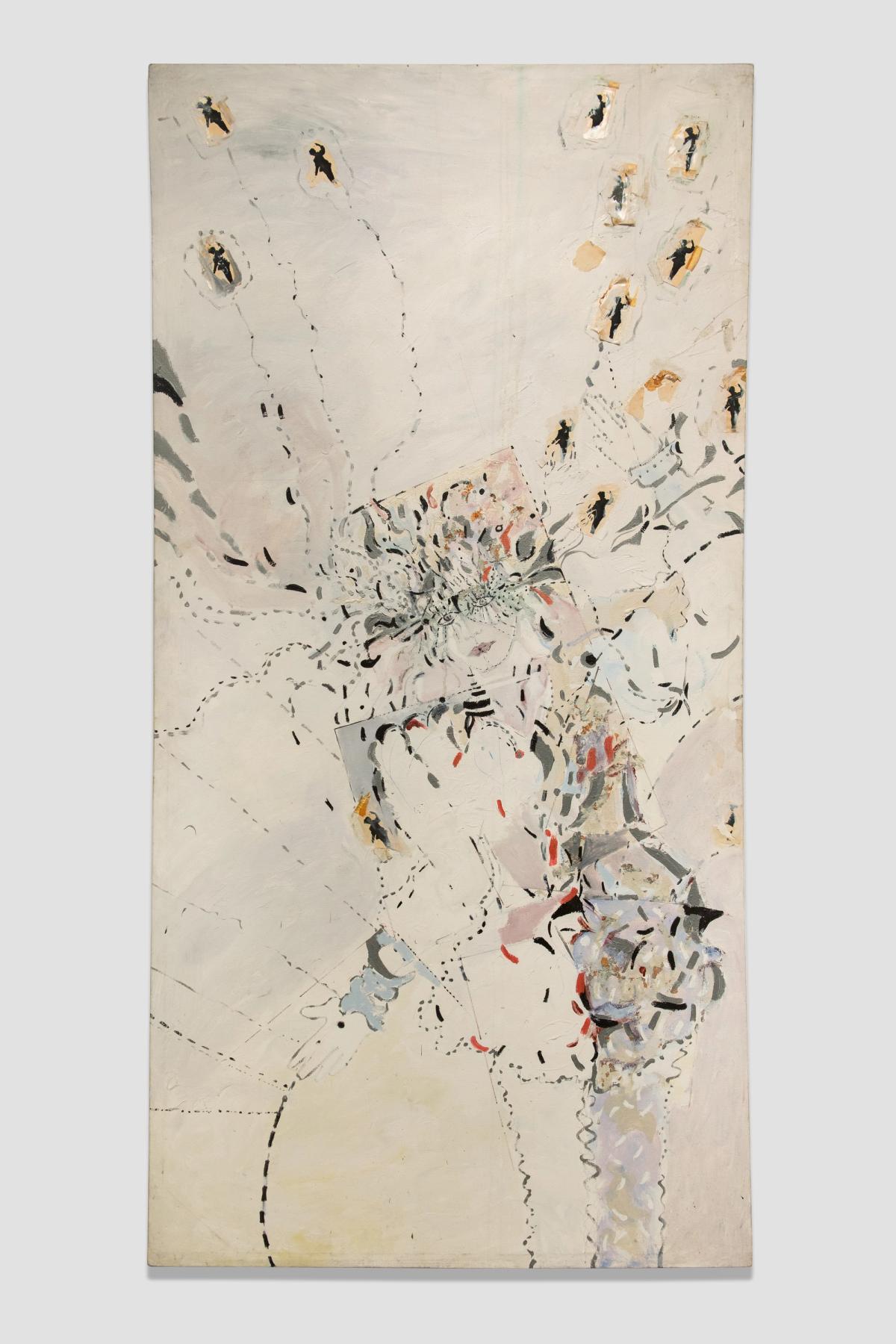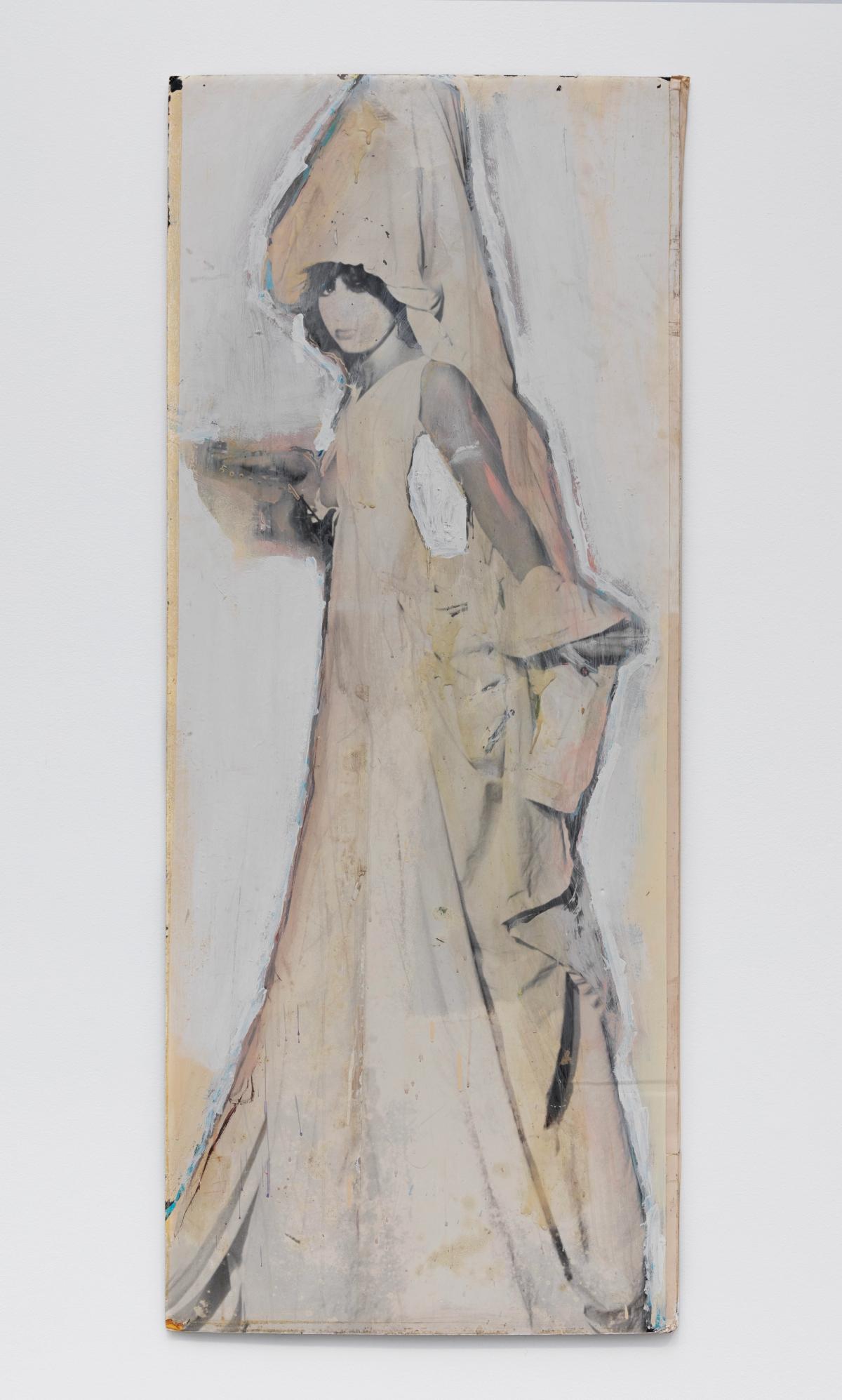Everything She Touches Turns To Gold
Colette Lumiere
Jan16–Mar12025
Each of her new identities has offered both an infiltration and a critique of the systems of value, fame, commodity, and art—always pushing the boundaries of what art might be and what we might expect it to look like.
- David J. Getsy, Pioneer Works 10.10.23
In a prolific career spanning over five decades, Colette Lumiere has demonstrated an unparalleled mastery of social codes, skillfully subverting them with a playful yet incisive flair across artistic mediums. Her work, rooted in both beauty and satire, delves into personal mythology while simultaneously critiquing the very systems it engages with. This dynamic tension between allure and critique has come to define her practice, allowing her to navigate—and transform—the boundaries of art, fashion, and identity.
For her second solo show at Company titled, Everything She Touches Turns To Gold, the gallery presents a collection of paintings that span various stages of Colette’s career, highlighting a foundational aspect of her oeuvre. Though more known for her use of experimental mediums, painting remains Colette's first discipline and a practice she has never fully abandoned. Her "metaphysical portraits," a near-daily ritual since the beginning, are created in the same spirit as her LP Covers and Postcards series, recording her art and life in an objective and timeless manner. Using signature symbols, gestures, and motifs—broken lines, dots, and patterns—that unify her diverse body of work, Colette transforms the gallery into an immersive environment, embodying her belief in art as a living, uncontainable force.
The ethereal figures in these paintings serve not only as stand-ins for Colette herself but also as bold assertions of her commitment to embedding her presence within the traditionally male-dominated canon of art history. Through the use of soft, flowing fabrics and delicate hues, accented in glitter and painted in a style reminiscent of classical frescos, Colette reclaims and redefines conventional narratives. What might initially be perceived as stereotypical symbols of femininity are, in her hands, powerful instruments of subversion, challenging and reimagining the legacies of art history from her distinctly performative perspective. The delicate yet commanding presence of these figures encapsulates one of Colette’s enduring artistic pursuits: to dismantle rigid hierarchies and create spaces where femininity is not only celebrated but also empowered.
Many of the paintings on view were created during the 1980s in Berlin, a period when Colette embodied the persona of Mata Hari and the Stolen Potatoes. This series epitomized Colette’s remarkable ability to transform the mundane into the extraordinary, by way of a subversive twist on the vamp aesthetic, channeling cultural icons like Theda Bara and Marlene Dietrich. Colette’s Berlin performances were nothing short of theatrical, often featuring dramatic elements such as a gold-draped Volkswagen filled with satin and “golden potatoes,” which she used for her debut at Fofi’s Nightclub. These glittering potatoes became an enduring motif, symbolizing her alchemical gift for transforming everyday objects into symbols of creative metamorphosis—akin to turning base metals into gold.
Mata Hari eventually expanded into a visual art band, first unveiled on the stage of New York’s Danceteria and later into city-wide installations and collaborative projects, including set designs for the Berlin Opera. The Silk to Marble Series, black-and-white portraits of Colette draped in a white sheet, striking classical, marble-like poses, symbolize new beginnings for the artist. Conceived just before her move to Berlin, the images were soon after realized as artworks and shown at Künstlerhaus Bethanien in 1985.
This pivotal chapter in her career is highlighted in the exhibition by a striking, large-scale billboard piece, originally displayed under the Yorckbrücken in Berlin. The work exemplifies Colette’s unique fusion of performative art and visual spectacle, turning public spaces into extensions of her artistic expression. By using urban environments as her stage, Colette further blurred the lines between high art and the raw energy of the streets, reshaping the boundaries of where and how art could be experienced, challenging its limitations and redefining the very spaces it inhabits.
Selected Works

Colette Lumiere
Billboard, Mata Hari and the Stolen Potatoes (Art Under the Yorckbrücken),
1985

Colette Lumiere
Portrait of Michael, 1,
1984

Colette Lumiere
The Oracle,
1972

Colette Lumiere
Justine in transit,
1983

Colette Lumiere
Mata Hari and The Stolen Potatoes Visual Art Band,
1984

Colette Lumiere
Self Portrait in Beautiful Dreamer Uniform,
1983

Colette Lumiere
Self Portrait in Beautiful Dreamer Uniform,
1983

Colette Lumiere
Self Portrait in Beautiful Dreamer Uniform,
1983

Potatoe No. 2 (Portrait of Peter),
1984

Potatoe No. 1 (Portrait of Majka),
1984

Colette Lumiere
Golden Potatoe,
2025

Colette Lumiere
Self Portrait (Sand Woman Series),
1973

Colette Lumiere
Silk to Marble Series,
1984 - 1985

Colette Lumiere
Silk to Marble Series,
1984 - 1985

Colette Lumiere
Silk to Marble Series,
1984 - 1985

Colette Lumiere
Silk to Marble Series,
1984 - 1985

Colette Lumiere
Mata Hari and the Stolen Potatoes Book,
1984 - 1985

Colette Lumiere
Mata Hari and the Stolen Potatoes in front of Berlin Wall 1985,
2025